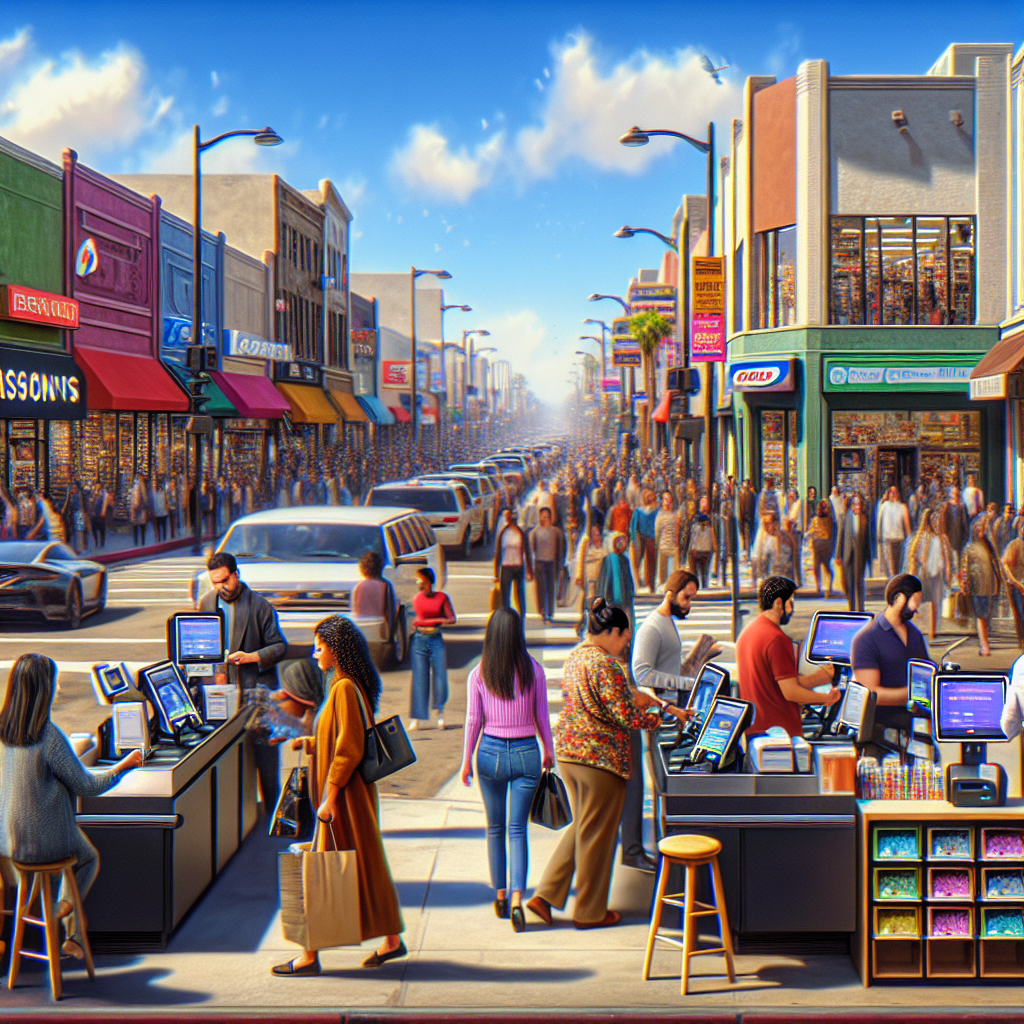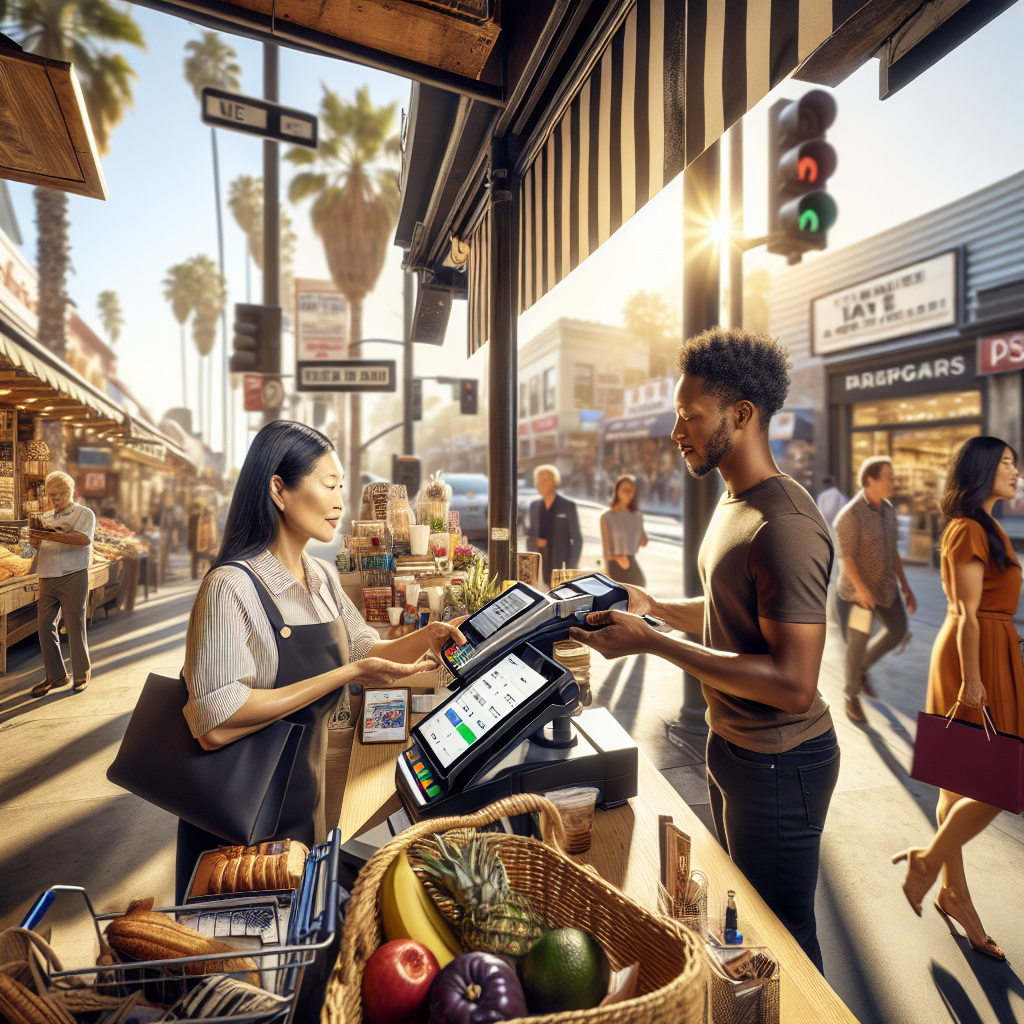Southern California is a vibrant region known for its dynamic retail landscape, ranging from bustling urban centers to quaint coastal towns. Understanding the intricacies of retail payments in Southern California is crucial for business owners aiming to thrive in this competitive market. The payment preferences and behaviors of consumers here are often influenced by the diverse culture and fast-paced lifestyle. Whether you’re a small boutique or a large chain, having a robust payment processing system is essential to cater to the needs of your customers.
At The Credit Card Guy, we are dedicated to helping your business navigate these complexities by offering state-of-the-art point-of-sale systems and reducing your monthly processing fees. If you’re interested in getting started contact us at 888-641-8910 or Email us.
In the following sections, we will delve deeper into the specific trends, challenges, and solutions surrounding retail payments in this region. From technological advancements to consumer expectations, we will cover everything you need to know to stay ahead of the curve. Stay tuned as we explore how to optimize your payment processes to enhance customer satisfaction and boost your bottom line.
Current Trends in Retail Payments


The retail payment landscape is continuously evolving, driven by technological advancements and changing consumer behaviors. In Southern California, several key trends are shaping the way businesses handle transactions. One significant trend is the increasing adoption of contactless payments. With the rise of mobile wallets such as Apple Pay and Google Wallet, consumers prefer the convenience and speed of tap-and-go transactions. This trend has been further accelerated by the COVID-19 pandemic, which heightened the demand for touchless payment solutions.
Another notable trend is the growing popularity of buy now, pay later (BNPL) services. Retailers are partnering with companies like Afterpay and Klarna to offer flexible payment options, allowing customers to spread their purchase cost over several installments. This trend appeals particularly to younger consumers who value financial flexibility without incurring high-interest debt.
Additionally, the integration of loyalty programs with payment systems is gaining traction. Retailers are leveraging data analytics to provide personalized rewards and discounts, enhancing customer loyalty and encouraging repeat business. By linking loyalty programs directly to payment methods, businesses can streamline the checkout process and offer seamless experiences.
Cryptocurrency is also making inroads into the retail sector. While not yet mainstream, some forward-thinking retailers in Southern California are starting to accept Bitcoin and other digital currencies, catering to tech-savvy customers and expanding their payment options.
These trends highlight the importance of staying updated with the latest payment technologies to meet consumer expectations and remain competitive. As the retail payment landscape continues to evolve, businesses must adapt and innovate to succeed in Southern California’s dynamic market.
Challenges Faced by Retailers


While the retail payment landscape in Southern California is brimming with opportunities, it also presents several challenges that retailers must navigate. One of the foremost challenges is the rising cost of payment processing fees. With multiple payment methods, including credit cards, mobile wallets, and BNPL services, the fees can quickly add up, eating into profit margins. Managing these costs effectively is crucial for maintaining financial health.
Another significant challenge is security. As digital payments become more prevalent, so do the risks associated with data breaches and fraud. Retailers must invest in robust security measures, such as encryption and tokenization, to protect sensitive customer information. Compliance with regulations like PCI-DSS (Payment Card Industry Data Security Standard) is not optional and requires ongoing attention and resources.
Moreover, the rapid pace of technological change can be daunting. Retailers need to constantly upgrade their point-of-sale (POS) systems to stay compatible with new payment methods and security protocols. This continuous need for technological advancements can be both time-consuming and costly, especially for small and medium-sized businesses.
Customer expectations also pose a challenge. Today’s consumers demand quick, seamless, and personalized checkout experiences. Meeting these expectations often requires integrating advanced payment solutions with customer relationship management (CRM) systems and loyalty programs. Failing to do so can result in lost sales and diminished customer satisfaction.
Lastly, competition in Southern California’s retail market is fierce. Retailers must differentiate themselves not only through their products and services but also through their payment options. Offering a variety of convenient and secure payment methods can be a key differentiator but requires significant investment and strategic planning.
Addressing these challenges effectively is essential for retailers to thrive in Southern California’s competitive market. By staying informed and agile, businesses can turn these obstacles into opportunities for growth and customer satisfaction.
Choosing the Right Payment Solutions


Selecting the right payment solutions is crucial for any retailer aiming to thrive in Southern California’s competitive market. The first step is to understand your customer base and their preferred payment methods. Whether it’s credit cards, mobile wallets like Apple Pay and Google Wallet, or Buy Now, Pay Later (BNPL) options, knowing what your customers prefer can greatly enhance their shopping experience and boost sales.
Next, consider the costs associated with various payment solutions. Different payment providers have different fee structures, which can include transaction fees, monthly fees, and additional costs for features like fraud protection and advanced analytics. It’s essential to compare these costs and choose a solution that offers the best balance between affordability and functionality.
Security should be a top priority. Look for payment solutions that offer robust security features such as encryption, tokenization, and compliance with PCI-DSS standards. These features can help protect sensitive customer data and prevent fraud, thereby building trust and loyalty among your customers.
Integration capabilities are another critical factor. Your chosen payment solution should seamlessly integrate with your existing point-of-sale (POS) system, e-commerce platform, and other business tools like CRM systems and inventory management software. This will not only streamline operations but also provide valuable insights into customer behavior and sales trends.
Scalability is also important, especially for growing businesses. A scalable payment solution can grow with your business, offering additional features and capabilities as your needs evolve. This can save you the hassle and expense of switching providers down the line.
Lastly, consider the level of customer support offered by the payment provider. Reliable, 24/7 customer support can be invaluable in resolving issues quickly and minimizing downtime. Look for providers with a strong reputation for excellent customer service and support.
By carefully evaluating these factors, retailers in Southern California can choose the right payment solutions that not only meet their current needs but also support their future growth and success.
Benefits of Advanced Payment Systems
Adopting advanced payment systems offers numerous benefits that can significantly enhance the efficiency and profitability of retail businesses in Southern California. One of the primary advantages is the ability to provide a seamless and frictionless checkout experience for customers. Modern payment systems support a variety of payment methods, including credit/debit cards, mobile wallets, and contactless payments, which can expedite the transaction process and reduce long queues at checkout.
Advanced payment systems also come equipped with sophisticated fraud detection and prevention mechanisms. These systems utilize technologies like AI and machine learning to detect unusual patterns and flag potentially fraudulent transactions. This not only protects your business from financial losses but also enhances customer trust by safeguarding their sensitive information.
Another significant benefit is the integration capability of advanced payment systems with other business tools. Seamless integration with POS systems, inventory management software, and CRM systems can streamline operations, reduce manual errors, and provide valuable insights into sales trends and customer preferences. This data can be leveraged to make informed business decisions, improve inventory management, and tailor marketing strategies to better meet customer needs.
Additionally, advanced payment systems often come with loyalty programs and customer engagement features. These tools can help you build stronger relationships with your customers by offering personalized rewards and promotions, thereby increasing customer retention and driving repeat business.
Scalability is another crucial advantage. As your business grows, advanced payment systems can easily scale to accommodate increased transaction volumes and new payment methods, ensuring that your operations remain efficient and uninterrupted.
Finally, many advanced payment systems offer robust reporting and analytics features. These tools provide detailed insights into sales performance, customer behavior, and payment trends, enabling you to identify opportunities for growth and optimization. By leveraging these insights, you can enhance your business strategies and drive long-term success.
Future of Retail Payments in Southern California


The landscape of retail payments in Southern California is rapidly evolving, driven by technological advancements and changing consumer preferences. As we look to the future, several trends are poised to reshape the way businesses handle transactions and engage with customers.
One of the most significant trends is the increasing adoption of contactless payments. With the growing popularity of mobile wallets and NFC-enabled devices, more consumers are opting for tap-and-go payment methods. This not only enhances the convenience and speed of transactions but also aligns with the heightened demand for hygienic, touch-free payment options in a post-pandemic world.
Another emerging trend is the integration of blockchain technology and cryptocurrencies into retail payment systems. Blockchain offers a secure and transparent way to process transactions, reducing the risk of fraud and enhancing trust. As cryptocurrencies become more mainstream, businesses in Southern California may start accepting digital currencies alongside traditional payment methods.
The rise of artificial intelligence (AI) and machine learning is also set to revolutionize retail payments. These technologies can be used to personalize customer experiences, optimize pricing strategies, and enhance fraud detection. For instance, AI-powered chatbots can assist customers in real-time, providing instant support and facilitating seamless transactions.
Additionally, the concept of omnichannel retailing is gaining traction. Businesses are increasingly adopting integrated payment solutions that provide a consistent and cohesive shopping experience across various channels—online, in-store, and mobile. This approach not only meets the diverse preferences of modern consumers but also helps businesses gather comprehensive data to drive targeted marketing and sales strategies.
As these trends continue to unfold, it’s crucial for businesses in Southern California to stay ahead of the curve by adopting advanced payment technologies and strategies. By doing so, they can enhance customer satisfaction, boost operational efficiency, and drive long-term growth.
If you’re interested in getting started, contact us at 888-641-8910 or Email us at The Credit Card Guy.





